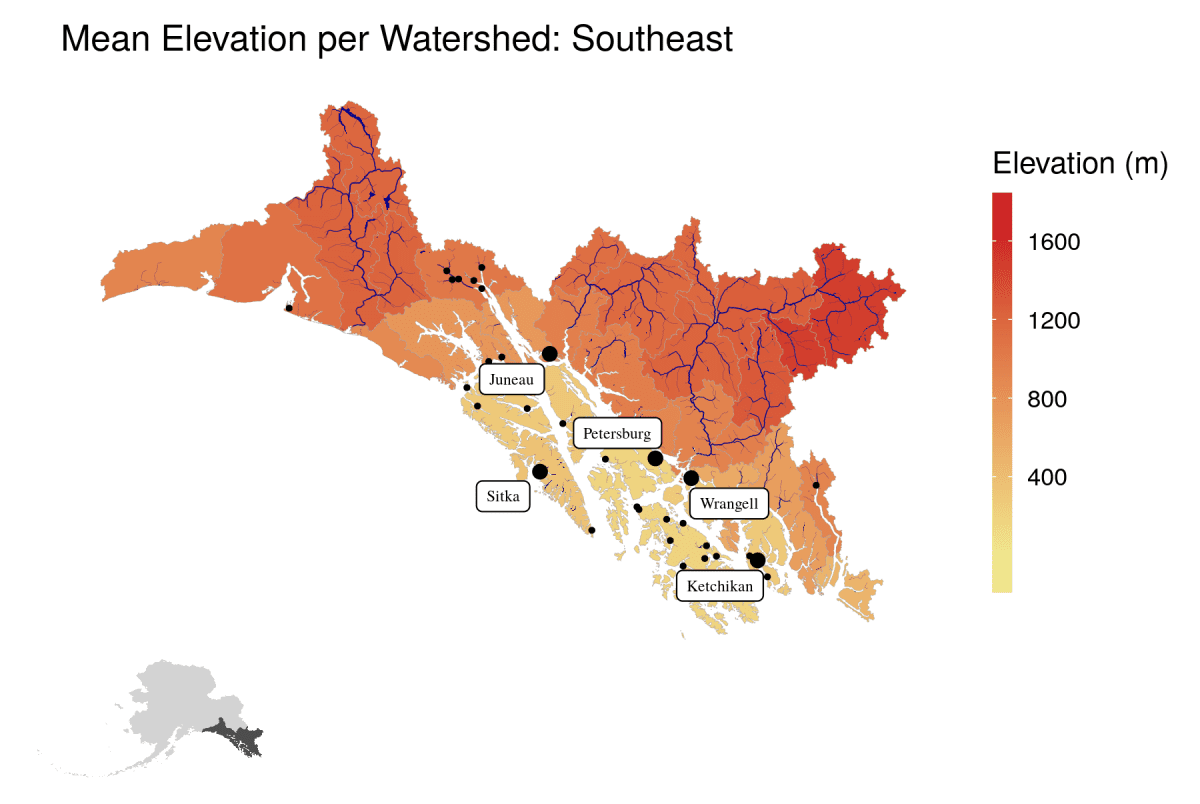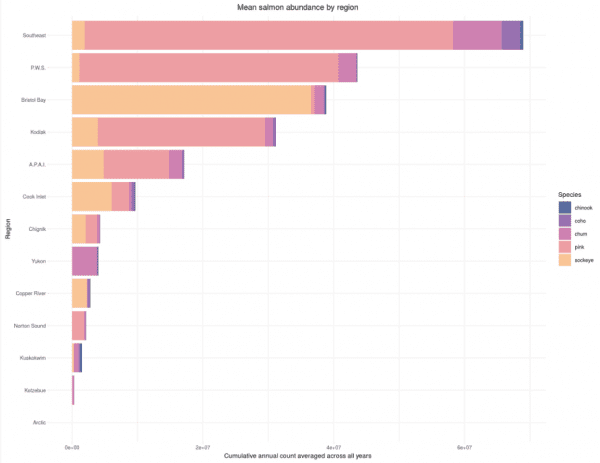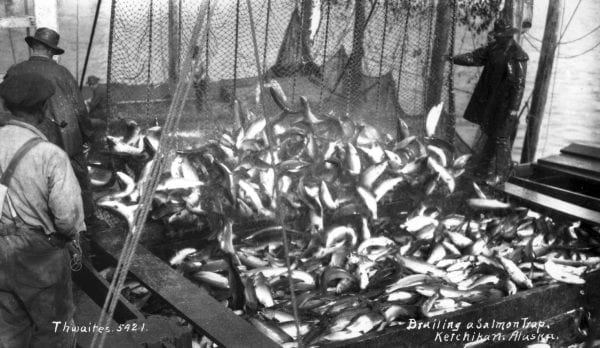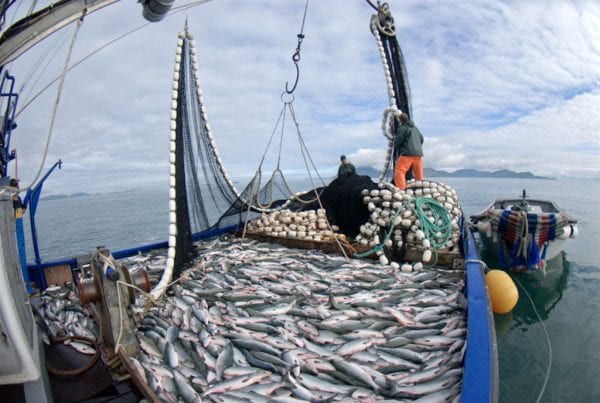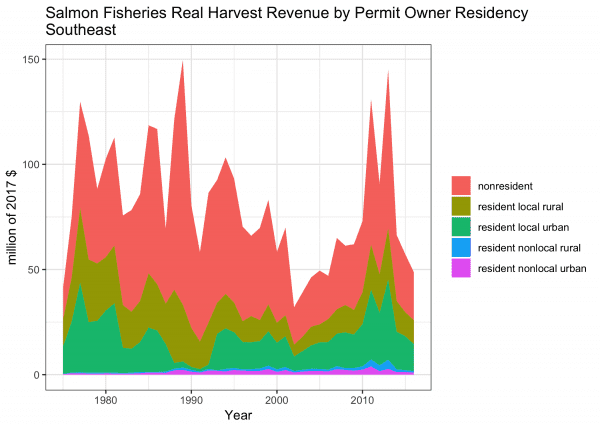The Pacific Salmon Commission
The Southeast region is distinctive in being the most implicated in the international management of salmon conducted through the Pacific Salmon Commission under the terms of the Pacific Salmon Treaty. The commission operates through five panels, four under its direct governance and special panels for species. Of the special panels, the Chinook panel is of greatest significance to governance of Alaska salmon as it manages treaty-wide Chinook harvests including those taken in southeast Alaska by commercial and sport fisheries. The PSC also directs funds to be used for rehabilitation and enhancement of depleted stocks – especially Chinooks – of the transboundaryHere’s some cite-reference content. I think it should be a little longer than just one sentence so I can compare it to another layout. rivers.
The Chinook Panel and its technical committee endeavor to manage stocks in US jurisdictions on a stock by stock basis. Southeast Alaska Chinook stocks considered in PSC management are the Situk, Alsek, Chilkat, Taku, Stikine, Unuk, and Chickamin three of which are also managed for in-stream harvests by the Transboundary Panel. Chinook escapements to all seven of these rivers were below lower level escapement goals in 2016 and 2017. The PSC establishes a quota for southeast Alaska Chinook harvests in the commercial fisheries.
The Northern Panel deals with issues associated with the harvest of intermingled southeast Alaska and northern British Columbia pink, chum and sockeye salmon caught in saltwater. Alaskan salmon stocks from the southern half of the region are the focus due to their capture in some British Columbia net fisheries. Likewise Alaskan fishermen intercept Canadian salmon headed primarily for the Nass and Skeena Rivers in purse seine and gillnet fisheries operating in areas near the border. The Alaskan interception fisheries are governed by quota percentage amounts associated with Nass and Skeena River sockeye stocks. The Alaska quota shared by purse seine and drift gillnet fishermen is approximately 16% of the total catch from these stocks. There have been substantial discrepancies from these quotas since they were initially established. Weak runs in recent years have led managers to reduce the fishing time in Alaskan waters where interceptions are known to occur.
The Transboundary Panel considers topics associated with three significant salmon producing transboundary rivers in the region – Alsek, Taku and Stikine. For each river, negotiations between 1999 and 2008 resulted in allocation agreements, management agreements, and enhancement agreements.
Allocations were developed from “baseline catch” data (BLCs). On the Alaskan side, commercial fisheries are associated with each river directed at Chinook, sockeye and coho runs. A federal subsistence fishery overseen by the Forest Service typically occurs in the lower Stikine River for federally qualified subsistence users including residents of Petersburg and Wrangell, the two communities closest to the fishery. The State of Alaska has authorized a personal use fishery in the Taku River since the residents of Juneau-Douglas, the closest community, do not qualify for subsistence uses under state or federal criteria (see subsistence section). A subsistence fishery for Chinook, coho and sockeye salmon is conducted when stock status allows at the mouth of Alsek River.
On the Canadian side, in-river commercial fisheries are authorized in the Stikine and Taku but not in the Alsek. First Nations harvests have a priority and occur on the basis of treaty agreements that allow harvest for food, social and ceremonial needs. First Nations have treaty-based specified quotas that are adjusted in-season based on abundance levels. They fish in customary locations during open periods established by Canadian fishery managers. Sport fisheries also occur in authorized areas in all three systems.
Governance cost of management of the southeast Alaskan transboundary program are paid for by the federal government and used to hire ADF&G staff in southeast Alaska.
North Pacific Fisheries Management Council
In southeast Alaska, federal waters outside three-miles are under the jurisdiction of North Pacific Fisheries Management Council (NPFMC) and managed through the National Oceanic and Atmospheric Administration (NOAA). The troll fishery, authorized only east of 175˚ west, primarily targeting migrating Chinook salmon stocks, has historically taken place in waters outside of three-miles throughout the region and is the only salmon fishery that takes place in federal waters offshore of the southeast region. The NPFMC operates fisheries in its waters through Fishery Management Plans (FMP). The plans are developed by scientists based on best available data. The federal salmon FMP is legally required to meet ten standards established for the conduct of federal fisheries noted earlier. Through the FMP, the troll fishery in southeast Alaska is conducted according to the terms of the Pacific Salmon Treaty and in-season management has been delegated to the State of Alaska based on evaluation that the State’s management successfully meets MSFMCA standards.

A portion of the Tsimshian Indian fishing fleet in the Metlakatla harbor on Annette Island Reservation. Source: Metlakatla Indian Community website
Metlakatla Indian Community
Located near the southern border of Alaska, the Annette Island Indian Reservation of the Tsimshian Indians is a unique Alaskan jurisdiction where governance is carried out through arrangements between the tribe, the federal government and the State of Alaska.
As a federally recognized tribe whose reservation is defined as Indian Country, the Metlakatla Indian Community exercises rights similar to those of most Native American Indian reservations and is not subject to state laws over its lands and waters. Established in 1915, the Tsimshian Fisheries Reserve provides that waters around the island out to 3,000 feet offshore are part of the reserve. Within those waters, the tribe, subject to federal oversight and concurrence, decides who, when and where salmon can be harvested. Tribal management has been delegated from the regional BIA director to the tribal Fisheries Management Board (FMB) that consists of the mayor and the BIA superintendent. They receive recommendations for the fisheries from the staff based on in-season data and historic patterns of harvest. All decisions are made by the FMB.
The tribe manages 50 streams that produce pink salmon and 34 that produce chum salmon on the reservation. The tribal salmon management plan outlines the practices adopted to maintain sustainable fisheries, provide for sharing with state fishermen and carry out the federal purpose of providing benefits for tribal members. Escapement goals have been set for streams and stream surveys are used to estimate the annual return. Areas are closed to fishing to protect stressed stocks.
The salmon fishery on the Annette Islands Reserve is the largest tribally-managed salmon fishery in the United States. The tribe has established troll, purse seine and drift gillnet salmon fisheries for tribal members. In order to fish in state or federal waters, Indian reservation resident fishermen must also hold State limited entry permits. The tribe is under the jurisdiction of the Pacific Salmon Commission for purposes of salmon conservation and subject to the fishing regimes established by the Northern Panel, although they are not represented on the technical committee of that panel.
Metlakatla’s harvests are reported to the Alaska Commercial Fisheries Entry Commission but done so as total purse seine and total drift gillnet harvests. In 2016, the tribe reported fish landings by 17 purse seine vessels and 74 drift gillnet vessels totaling 1,940,311 salmon with an ex-vessel value of $4.1 million. Approximately 250 persons were employed in commercial salmon fishing. For the first time in over 25 years of reporting, average fish caught per day by the Metlakatla purse seine fleet exceeded the remainder of the southeast Alaska purse seine fleet. Metlakatlan fishermen caught approximately 6.1% of the southern southeast salmon harvest.
Metlakatlan salmon fishery openings allowed approximately double the time for other southeast purse seine fisheries and approximately 10% more fishing time for the drift gillnetters compared to the southeast gillnet fleet. The tribe operates a fish processing facility in partnership with Silver Bay Seafoods. The tribe operates the Tamgas Fish Hatchery that produces chum and coho most of which are caught in terminal fisheries in tribal waters. In the past, the reservation used floating fish traps to catch salmon and retains the right to use that gear even though it is illegal in nearby state waters.
Glacier Bay National Park and Preserve
An important jurisdiction of southeast salmon governance is Glacier Bay National Park and Preserve (GBPP). In 1980 ANILCA authorized subsistence uses in most newly created federal jurisdictions; however it banned subsistence activities in Glacier Bay National Park long utilized for subsistence salmon by the Tlingit people of Hoonah. In 1999, the Glacier Bay Fishing Act banned commercial fishing in Glacier Bay National Park except for a cohort of fishermen who qualified to continue their fisheries for their lifetimes. They were granted Lifetime Access Permits (LAPs) that can neither be sold nor transferred and would allow the holder to continue fishing as long as they could subject to state regulations of the fishery for which they qualified.
Power and hand trolling as well as purse seining for salmon – traditional commercial gears operated in park waters – would be allowed to continue only for permitted individuals based on Alaska fisheries management policies. A recent assessment by NPS indicates that few of the LAP holders are now fishing in Glacier Bay National Park waters. While commercial and subsistence salmon fisheries in the park were wiped out, a limited amount of guided sport fishing for salmon continues to be allowed. Only a limited number of guides are authorized by permit to conduct sport fishing activities in the park subject to state and federal regulation.
Timber extraction and the Tongass National Forest
Development and its impacts on salmon in southeast Alaska have a long history related primarily to timber extraction (logging and associated activities) and mineral extraction. Major timber development and impacts associated with the clear-cutting of mature forest began in 1947 when two fifty-year sales of Tongass National Forest trees to pulp producing companies were consummated. Following those sales, major logging of substantial contiguous acreage, known as clearcutting, was undertaken focusing most intensively on Prince of Wales Island and other areas of the southern part of the region. The rates of harvest were initially intended to track a 100 year replacement cycle for the forest but actual harvest of mature forest occurred at a much more rapid rate.
Timber harvest and management in the Tongass National Forest became a major national issue in the 1980s and 1990s. In 2001 the US Forest Service implemented the so-called “Roadless Rule” for all National Forests ending most road construction and in Alaska essentially halting logging on Tongass National Forest lands. In 2018, the Forest Service announced its intention to develop a new rule for Alaska only that would allow new road construction. The issue is extremely controversial in southeast Alaska as development interests favor the new rule and environmental interests oppose it. Former Governor Walker, who indicated support for a new rule, convened an advisory panel on the issue in October, 2018.
There are many issues associated with the impact of forest harvesting on salmon reproduction including spawning habitat destruction and degradation, loss of canopy protecting resident salmon and sediment deposition damaging spawning habitat. Another significant impact as discussed earlier are the placement of culverts in anadromous streams that may prevent salmon movement and prevent spawning or outmigration. In order to accomplish timber harvest in areas away from the coast and transport logs to locations where they can be processed or shipped, extensive road building is necessary. The road system in the Tongass National Forest classifies roads as permanent or temporary. Such roads have been present in some places for over 60 years.
In 2001, US Forest Service and ADF&G Habitat and Restoration division personnel conducted a road status study pertaining to fish passage and water quality on Tongass roads. The first phase of the research examined 2173 miles of permanent roads amounting to 60% of the permanent roads in the forest. A total of 273 culverts across anadromous fish streams were identified of which 179 (66%) were “assumed to block fish passage.” Four most frequent problems associated with culverts identified were altered water velocity, perching, blockage and structural damage. The standard fish used for the analysis is a coho smolt, the most likely salmonid to be found throughout the waters of anadromous fish streams in southeast Alaska. A program of replacement and maintenance has been undertaken by the Forest Service to correct the identified culvert problems.
Mineral Extraction
Mineral extraction is also a significant current issue in southeast Alaska. The Chilkat River drainage is one of the few major streams outside the federal jurisdiction of the Forest Service or National Park Service in southeast Alaska. Most of the Chilkat River valley acreage that is not held by the Klukwan village corporation or tribe is under the jurisdiction of the State of Alaska. A substantial gold mining operation is under development by Constantine Metal Resources Ltd. of Canada on a tributary of the Klehini River that flows into the Chilkat River near the village of Klukwan.
The firm has engaged in exploratory drilling in the area and intends to prepare a development plan for this gold-zinc prospect. It has obtained permits from the Bureau of Land Management (BLM) for that purpose. In December 2017, the Chilkat Indian Tribe of Klukwan and three conservation groups sued the U.S. Bureau of Land Management (BLM) for failing to consider the future impacts of mine development before approving an exploration plan for a hardrock mine project in the Chilkat River watershed. Tribal opposition to the mine is based on the threat that mine activities pose for water quality and salmon reproduction.
A major area of governance concern over mining activities in the southeast region are Canadian mines that are positioned at the headwaters of southeast Alaskan rivers that support salmon runs. There are eight recognized transboundary rivers that support salmon runs in Alaska. Dangers posed by the mines include acid-mine drainage, heavy metals pollution and catastrophic dam failure. In 2014, an earthen dam at the Mount Polley dam in central British Columbia collapsed spilling massive quantities of toxic sludge into the Fraser River, the province’s largest salmon producing system. This event prompted concern and brought attention to identify what Canadian mines were operating in Alaska River headwaters. The Tulsequah Chief mine has been operating just over the border on a tributary of the Taku River for over 60 years sending toxic wastes down the river. A large-scale Canadian mine, Red Chris, opened in 2015 in the headwaters of southeast Alaska’s Stikine River, one of the state’s most prolific salmon producers. Red Chris –owned by the same company responsible for the Mount Polley mine disaster –is one of six large-scale mines that British Columbia is aggressively developing in the transboundary region straddling B.C. and Alaska. There are four other mines or mine prospects currently operating or in development in the headwaters areas.
Following the opening of Red Chris, Governor Walker initiated contacts with the British Columbia government on the issue of mining activities and transboundary rivers in 2015. In 2015 a memorandum of understanding between the State of Alaska and the Province of British Columbia was signed to establish a process of communications and information exchange. In 2017, Senators Murkowski and Sullivan and Representative Young sent a letter to Secretary of State Tillerson requesting State Depart attention to the issue of transboundary mines “to impress upon their Canadian counterparts the critical need for binding protections, joint water quality monitoring, and financial assurances to protect Americans downstream of large-scale Canadian mines.”
Engagement did happen at the federal level. Under the Boundary Waters Treaty, the US and Canada have established the International Joint Commission to act on treaty-related issues. Article IV of the treaty requires full mitigation of potential impacts on waters of the other nation and addresses mining discharge issues. The US Commissioners accused the British Columbia parties of refusing to refer the mining issues to this body. The revelation makes clear what is at risk for Southeast Alaska if it remains unprotected from B.C. mines near the headwaters of transboundary rivers — and Alaska’s urgent need for binding enforceable protections and financial assurances, which only federal action can achieve.
In June 2018, Alaska and British Columbia held an information exchange meeting in keeping with the memorandum of understanding. Subsequently, in October 2018, Senators Lisa Murkowski and Dan Sullivan, Representative Don Young, Governor Bill Walker, and Lt. Governor Byron Mallott sent letter urging Secretary of State Mike Pompeo and the U.S. Department of State to act to defend Alaskan interests, salmon, and salmon-producing rivers from under-regulated mining activity in transboundary British Columbian / Alaskan watersheds. In the interim, Governor Walker has set up an advisory panel and continued discussions with British Columbia counterparts in an effort to move toward an agreement that addresses the major issues necessary to provide protections for Alaskan interests.
The issue of governance of potential impacts of Canadian mines on Alaskan environments and especially salmon rivers also raised concerns among southeast Alaska tribes. In 2014 the Southeast Alaska Indigenous Transboundary Commission (SEITC) was created as a consortium of 15 sovereign Tribal nations located in Southeast Alaska. The purpose of the SEITC is to protect the vital and sacred rivers essential to their communities and culture. SEITC derives its authority from Tribal governments. The organization has held discussions with the State of Alaska and with British Columbia tribes concerning transboundary rivers and potential threats from mining activities to the rivers and has called on the Department of Commerce to intervene to bring these issues before the IJC.
